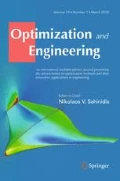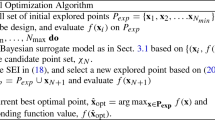Abstract
This paper presents a Sequential Approximate Optimization (SAO) procedure that uses the Radial Basis Function (RBF) network. If the objective and constraints are not known explicitly but can be evaluated through a computationally intensive numerical simulation, the response surface, which is often called meta-modeling, is an attractive method for finding an approximate global minimum with a small number of function evaluations. An RBF network is used to construct the response surface. The Gaussian function is employed as the basis function in this paper. In order to obtain the response surface with good approximation, the width of this Gaussian function should be adjusted. Therefore, we first examine the width. Through this examination, some sufficient conditions are introduced. Then, a simple method to determine the width of the Gaussian function is proposed. In addition, a new technique called the adaptive scaling technique is also proposed. The sufficient conditions for the width are satisfied by introducing this scaling technique. Second, the SAO algorithm is developed. The optimum of the response surface is taken as a new sampling point for local approximation. In addition, it is necessary to add new sampling points in the sparse region for global approximation. Thus, an important issue for SAO is to determine the sparse region among the sampling points. To achieve this, a new function called the density function is constructed using the RBF network. The global minimum of the density function is taken as the new sampling point. Through the sampling strategy proposed in this paper, the approximate global minimum can be found with a small number of function evaluations. Through numerical examples, the validities of the width and sampling strategy are examined in this paper.
Similar content being viewed by others
References
An W, Sun Y (2006) An equivalence between SILF-SVR and ordinary Kriging. Neural Process Lett 23:133–141
Andras P (2002) The equivalence of support vector machine and regularization neural networks. Neural Process Lett 65:97–104
Arora JS (1989) Introduction to optimum design. McGraw-Hill, New York
Coello Coello CA (2000) Use of a self-adaptive penalty approach for engineering optimization problems. Comput Ind 41:113–127
Donald J, Schonlau M, Welch WJ (1998) Efficient global optimization of expensive black-box functions. J Glob Optim 13:455–492
Fang H, Horstemeyer MF (2006) Global response approximation with radial basis function. Eng Optim 38(4):407–424
Haykin S (1994) Neural networks: a comprehensive foundation. Macmillan Co, New York, pp 236–284
Hu XH, Eberhart RC, Shi YH (2003) Engineering optimization with particle swarm. In: IEEE swarm intelligence symposium, pp 53–57
Huang D, Allen TT, Notz WI, Zeng N (2006) Global optimization of stochastic black-box systems via sequential Kriging meta-models. J Glob Optim 34:441–466
Hussain MF, Barton RR, Joshi SB (2002) Metamodeling: radial basis functions, versus polynomials. Eur J Oper Res 138:142–154
Jin R, Chen W, Simpson TW (2001) Comparative studies of metamodelling techniques under multiple modelling criteria. Struct Multidiscip Optim 23:1–13
Kurtaran H, Eskandarian A, Marzougui D, Bedewi NE (2002) Crashworthiness design optimization using successive response surface approximations. Comput Mech 29:409–421
Martin JD, Simpson TW (2005) Use of Kriging models to approximate deterministic computer models. AIAA J 43(4):853–863
McDonald DB, Grantham WJ, Tabor WL, Murphy MJ (2007) Global and local optimization using radial basis function response surface models. Appl Math Model 31:2095–2110
Muller AA, Messac A (2005) Extended radial basis functions: more flexible and effective metamodeling. AIAA J 43(6):1306–1315
Myers RH, Montgomery DH (1995) Response surface methodology. Wiley, New York
Nakayama H, Arakawa M, Sasaki R (2002) Simulation-based optimization using computational intelligence. Optim Eng 3:201–214
Orr MJL (1996) Introduction to radial basis function networks. http://www.anc.ed.ac.uk/rbf/rbf.html (On-line available)
Perez VM, Renaud JE, Watson LT (2002) Adaptive experimental design for construction of response surface approximations. AIAA J 40(12):2495–2503
Poggio T, Girosi F (1990) Networks for approximation and learning. Proc IEEE 78(9):1481–1497
Ray T, Saini P (2001) Engineering design optimization using swarm with an intelligent information sharing among individuals. Eng Optim 33:735–748
Rodriguez JF, Perez VM, Padmanabhan D, Renaud JE (2001) Sequential approximate optimization using variable fidelity response surface approximations. Struct Multidiscip Optim 22:24–34
Sasena MJ, Papalambros PY, Goovaerts P (2002a) Exploration of metamodeling sampling criteria for constrained global optimization. Eng Optim 34(3):263–278
Sasena MJ, Papalambros PY, Goovaerts P (2002b) Global optimization of problems with disconnected feasible regions via surrogate modeling. In: 9th/ISSMO symposium on multidisciplinary analysis and optimization, AIAA2002-5573
Sharif B, Wang GG, EiMekkawy TY (2008) Mode pursuing sampling method for discrete variable optimization on expensive black-box functions. J Mech Des 130:021402
Simpson TW, Mistree F (2001) Kriging models for global approximation in simulation-based multidisciplinary design optimization. AIAA J 30(12):2233–2241
Simpson TW, Mauery TM, Korte JJ, Mistree F (2001a) Kriging models for global approximation in simulation-based multidisciplinary design optimization. AIAA J 39(12):2233–2241
Simpson TW, Peplinski JD, Kock PN, Allen JK (2001b) Metamodels for computer-based engineering design: survey and recommendations. Eng Comput 17:129–150
Sobester A, Leary SJ, Keane AJ (2005) On the design of optimization strategies based on global response surface approximation models. J Glob Optim 33:31–59
Wang GG (2003) Adaptive response surface method using inherited Latin hypercube design points. J Mech Des 125:210–220
Wang GG, Shan S (2007) Review of metamodeling techniques in support of engineering design optimization. J Mech Des 129:370–380
Author information
Authors and Affiliations
Corresponding author
Rights and permissions
About this article
Cite this article
Kitayama, S., Arakawa, M. & Yamazaki, K. Sequential Approximate Optimization using Radial Basis Function network for engineering optimization. Optim Eng 12, 535–557 (2011). https://doi.org/10.1007/s11081-010-9118-y
Received:
Accepted:
Published:
Issue Date:
DOI: https://doi.org/10.1007/s11081-010-9118-y




